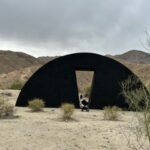Long ago and far away, I stayed in a quaint little motel with shabby antiques and a kind of creepy kitchenette. It had benefits: good star gazing and walking distance from Pappy and Harriet’s, where I’d gone to see one concert or another.
That used to be the Pioneertown Motel. But, times, and motel rooms, have changed. Now showing off a sleek but mellow modern desert chic vibe, the stars are still there for the watching – along with the perfect viewing spot, a bright stone outdoor fireplace to keep you warm, and you’re still walking distance to music and the desert version nightlife.
Today’s Pioneertown Motel is welcoming, warm, and western in style – the motel office is a dusty looking little miner’s shack, the rooms feature touches like cowhide on the floor and wagon wheel lamps on the ceiling. The rooms are spacious, artistically simple, and include touches of western art and artifacts along with location-themed art and plants. Furniture maker Dan Anderson has created comfortable, versatile, aesthetically fitting furnishings – think wood and leather.
A big game room, called the Canteen, has outdoor and indoor tables, and houses a fridge for cold beverages, as well as offering a nice stash of games and books and magazines.
The Red Dog Saloon, from the same affable and stylish owners as the motel, is a short stroll away, and offers tacos and brews and whiskeys in a comfortably clubby room just steps from that outdoor fireplace, should you be able to tear yourself away. it’s open for breakfast, lunch, and dinner – try the mushroom taco and the Rajas Quesadilla with smoky pasilla peppers. And, the aforementioned Pappy and Harriet’s still serves up BBQ and music just a few steps further on.
When we stayed at the motel we had a unique experience which made us love it even more: PG&E was doing line repair work, and power was out for a few hours. It was just us, the firelight, the stars, and the sound of the desert wind. While you probably won’t have that experience, the desert’s drama and magic is still right outside the door. The Pioneer Mountains Reserve is a great spot for hiking or horseback riding, and of course you’re also a short drive from Joshua Tree National Park.
So giddyup partner, and head on out to Pioneertown, where the motel is now blissfully luxe – but not pretentious, no siree; the view as pristine as ever; the stars just as bright.
- Genie Davis; photos by Genie Davis












































































































































